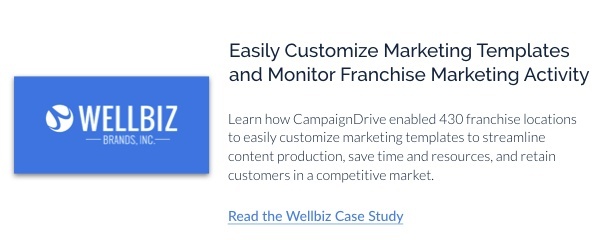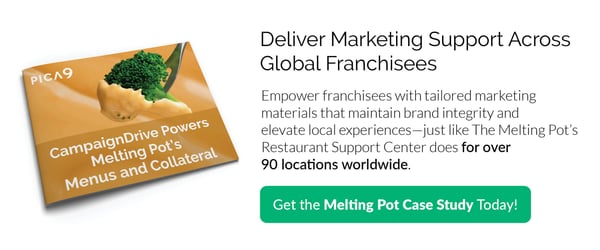Trying to manage distributed marketing without a tool for digital asset management (DAM) is a huge challenge for brand managers and creative directors. Brands are quickly turning to DAM tools to improve the organization, storage, and access surrounding their campaigns and marketing assets.
If you're suffering from analysis paralysis, you're not the only one. Capterra lists 207 options for digital asset management software, which range from highly-specialized local marketing tools to complex marketing suites that can do it all.
What type of DAM does your brand need? And which DAM vendor is the best for your marketing? Read on to find out...
The 4 Main Types of DAM Software
Gartner Research has identified four different categories of DAM.
The four types of DAM technology are:
- Stand-alone: General-purpose DAM designed to be integrated into existing technology for multi-channel output to websites, portals, and other marketing platforms.
- Modular: Some DAM tech consists of a series of tech modules, which can be used alone or as part of a set of tools. These modules may include web management, applications, web forms, and workflows.
- Integrated: These DAM solutions are pre-integrated with a broader suite of marketing tools, such as marketing resource management or marketing automation.
- Distributed: DAM that are designed specifically for the needs of distributed brands. These solutions assist in distributing marketing assets across local partners, geographic locations, or franchise locations.
Which DAM Solutions are the Best?
With many options on the market, brands looking for a digital asset management solution may feel overwhelmed. We've selected five DAM vendors offering an array of options for DAM. In this post, we focus on Stand-alone and Distributed DAM, as they fit a broad range of use cases and are relevant for both general-purpose DAM and distributed branding needs.
Read on to discover which digital asset management tool might be the best fit for your brand.
Digital Asset Management Software Reviews for 2017
1. WebDAM
This stand-alone DAM solution was designed to solve the needs of big brands, without being hard to use or difficult to implement. It's cloud-based - available as software-as-a-service (SaaS) via web access. While this DAM consists of two distinct products, WebDAM and BrandConnect, their best-known solution is WebDAM. Its features include:
- Digital asset library
- Asset metadata
- Asset life-cycle management
- Discovery and search options
- Tools for multiple asset formats
Many of the consumer-focused brands who choose this product are drawn to the simple user interface, easy integrations, and the user-friendly interface. According to the WebDAM website, their current customers include notable enterprise brands such as Tabasco, Norwegian Cruise Line, Crocs, and Seattle's Best Coffee.
2. Widen
This stand-alone marketing technology was one of the first in the market to offer web-based, SaaS solutions for DAM. In addition to the standard DAM features for asset storage and retrieval, Widen offers extensive options for workflows, creative approvals, and data analytics.
Widen also offers professional services and consulting for clients who are new to DAM or in the process of transitioning tech. Their internal talent can also support the digital content production needs of clients, with services that include simple design, workflow management, and production automation.
Notable customers using Widen include Cornell University, LG, Steelcase, and Kohler.
3. Canto
Stand-alone, SaaS DAM provider Canto has been around since 1992. They are well-regarded in the DAM space, as they continuously deliver innovation. Canto currently offers the following products:
- Culumulus: a highly-sophisticated, comprehensive DAM for enterprises. This tool remains a product-of-choice for many enterprise users who need a mature DAM.
- Flight: launched in 2014, Flight can act in conjunction with Cumulus. This DAM tool is focused on customer-facing apps. While Flight has the same level of sophistication that made Cumulus well-known, it's lighter-weight and easier-to-use. Flight is also tailored to contemporary customer marketing tasks like social media management.
While Canto was one of the earliest DAM solutions, they continue to push the bar in terms of innovation. They recently started offering integration with popular chat and file-sharing tool Slack. Canto customers include Wells Fargo, Honda, and Lufthansa.
4. ADAM Software
Since 2006, stand-alone DAM vendor ADAM Software has operated as a "smart content hub" for complex enterprise needs. They are unique among other well-regarded DAM software, as they operate a multi-channel approach. In addition to digital asset management capabilities, ADAM customers unlock access to serious functionality. ADAM includes (or can be scaled to include):
- Broad file support
- Translation
- Annotation
- Digital rights management
ADAM is designed to securely integrate with a number of other known marketing technologies, including Sitecore, Aprimo, Lionbridge, and SAP Hybris. Their customers include Lego, Ikea, and the Home Depot.
5. CampaignDrive by Pica9
CampaignDrive, by Pica9, is designed specifically for the needs of distributed marketing operations. This tool is built for global brands, franchises, and other organizations with unique DAM needs.
A SaaS-based platform, CampaignDrive is designed to introduce automation into local marketing execution. In addition to a sophisticated DAM tool, CampaignDrive customers can unlock:
- Highly-flexible templates designed for specific, compliant edits by distributed partners
- The ability to control content access by partner role, geography, or other factors
- Local partner usage analytics
CampaignDrive also neatly integrates with a brand's existing technology stack. This allows distributed brands with unique DAM challenges to reach new efficiency with budgeting, external vendor relations, CRM integration, omni-channel marketing execution, and much more. Customers of Pica9 include Marriott, The Melting Pot, Wellbiz Brands, and Polaris.
Selecting the Right DAM for YOUR Needs
Choosing between the the 19 DAM options listed in the Gartner report can be an overwhelming task for brand managers who are new to this technology. If you're finally making the move away from using file transfer protocol (FTP) sites for digital asset management, it can be difficult to envision using the"extra features" of many DAMs.
Gartner recommends that creative directors and brand managers start by understanding the four categories of DAM. Does your brand need a standalone, modular, integrated, or distributed tool? By evaluating your business model against these classes, you can significantly narrow your options.
When moving towards any new marketing technology, it's critical to look beyond the obvious factors like technical fit and licensing. If your DAM has a poor user-experience or too little post-sales support for your needs, getting value from the software could prove challenging.






